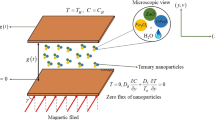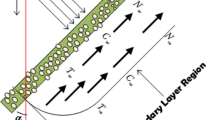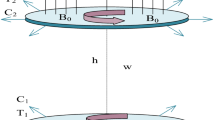Abstract
The current work explores the intelligent computational strength of neural networks based on the Levenberg–Marquardt backpropagation (LMBP-NNs) neural networks technique for simulation of Maxwell nanofluid flow past a linear stretchable surface model. The fluid flow is incorporated Rosseland’s thermal radiation, and Darcy’s Forchheimer law. The Maxwell nanofluid model gives more relaxing time to momentum boundary layer. For the nanofluid phenomena that concentrate on thermophoresis and Brownian motion, Buongiorno’s model is used. The procedure transforms partial differential equations arising in nanofluidics systems with an appropriate degree of similarity into nonlinear differential equation systems. For the nonlinear nanofluid problem with accuracy having order 4–5, the (FDM) finite difference method (Lobatto IIIA) is implemented via various selections of collocation points. The strong aspect of Lobatto IIIA is its ability to handle very nonlinear couple differential equations in an easy manner. The precise results of (FDM) are used to build the reference datasets for LMBP-NNs technique for the various factors of fluid problem. The design scheme for various factors of fluid problem carries out a series of operations based on training, testing, and authentication on reference dataset. The accuracy of LMBP-NNs is checked through statistical based neural network tools such that mean square error, regression plot, curve fitting graphs, and error histogram. Furthermore, the investigation of flow model parameters for momentum, energy, and concentration profiles is described via visual representation.






















Similar content being viewed by others
Data Availability Statement
This manuscript has associated data in a data repository. [Authors’ comment: The data that support the findings of this study are available within the article.]
References
S.U. Choi, J.A. Eastman. Enhancing thermal conductivity of fluids with nanoparticles (No. ANL/MSD/CP-84938; CONF-951135-29). (Argonne National Lab. (ANL), Argonne, 1995)
A. Moita, A. Moreira, J. Pereira, Nanofluids for the next generation thermal management of electronics: A review. Symmetry 13(8), 1362 (2021)
R.D. Jilte, R. Kumar, M.H. Ahmadi, Cooling performance of nanofluid submerged vs. nanofluid circulated battery thermal management systems. J. Clean. Prod. 240, 118131 (2019)
T. Fahim, S. Laouedj, A. Abderrahmane, S. Alotaibi, O. Younis, H.M. Ali, Heat transfer enhancement in parabolic through solar receiver: a three-dimensional numerical investigation. Nanomaterials 12(3), 419 (2022)
A.C. Eringen, Theory of micropolar fluids. J. Math. Mech. 16(1), 1–18 (1966). http://www.jstor.org/stable/24901466
A.C. Eringen, Theory of thermomicrofluids. J. Math. Anal. Appl. 38(2), 480–496 (1972)
J.O. Kessler, The external dynamics of swimming micro-organisms. Prog. Phycol. Res. 4, 258–307 (1986)
T.J. Pedley, N.A. Hill, J.O. Kessler, The growth of bioconvection patterns in a uniform suspension of gyrotactic micro-organisms. J. Fluid Mech. 195, 223–237 (1988)
M. Turkyilmazoglu, Flow and heat over a rotating disk subject to a uniform horizontal magnetic field. Z. für Naturforschung A 77(4), 329–337 (2022)
N.S. Anuar, N. Bachok, M. Turkyilmazoglu, N.M. Arifin, H. Rosali, Analytical and stability analysis of MHD flow past a nonlinearly deforming vertical surface in carbon nanotubes. Alex. Eng. J. 59(1), 497–507 (2020)
L.T. Benos, E.G. Karvelas, I.E. Sarris, Crucial effect of aggregations in CNT-water nanofluid magnetohydrodynamic natural convection. Therm. Sci. Eng. Prog. 11, 263–271 (2019)
A. Alhowaity, H. Hamam, M. Bilal, A. Ali, Numerical study of Williamson hybrid nanofluid flow with thermal characteristics past over an extending surface. Heat Transf. 51(7), 6641–6655 (2022)
L.T. Benos, E.G. Karvelas, I.E. Sarris, A theoretical model for the magnetohydrodynamic natural convection of a CNT-water nanofluid incorporating a renovated Hamilton-Crosser model. Int. J. Heat Mass Transf. 135, 548–560 (2019)
A.A. Gkountas, L.T. Benos, G.N. Sofiadis, I.E. Sarris, A printed-circuit heat exchanger consideration by exploiting an Al2O3-water nanofluid: Effect of the nanoparticles interfacial layer on heat transfer. Therm. Sci. Eng. Prog. 22, 100818 (2021)
M.E. Ghoneim, Z. Khan, S. Zuhra, A. Ali, E. Tag-Eldin, Numerical solution of Rosseland’s radiative and magnetic field effects for Cu-Kerosene and Cu-water nanofluids of Darcy–Forchheimer flow through squeezing motion. Alex. Eng. J. 64, 191–204 (2023)
I. Haq, M.F. Yassen, M.E. Ghoneim, M. Bilal, A. Ali, W. Weera, Computational study of MHD Darcy–Forchheimer hybrid nanofluid flow under the influence of chemical reaction and activation energy over a stretching surface. Symmetry 14(9), 1759 (2022)
D.A. Nield, A. Bejan, Convection in porous media, vol. 3 (Springer, New York, 2006)
G. Karniadakis, A. Beskok, N. Aluru, Microflows and nanoflows: fundamentals and simulation, vol. 29 (Springer, London, 2006)
A.A. Siddiqui, M. Turkyilmazoglu, Natural convection in the ferrofluid enclosed in a porous and permeable cavity. Int. Commun. Heat Mass Transf. 113, 104499 (2020)
M. Turkyilmazoglu. Radially expanding/contracting and rotating sphere with suction. Int. J. Numer. Methods Heat Fluid Flow. 32(11), 3439–3451 (2022). https://doi.org/10.1108/HFF-01-2022-0011
L. Rybach, R. Hopkirk. Shallow and deep borehole heat exchangers—achievements and prospects. In Progress World Geothermal Congress, vol. 1995. (1995), pp. 2133–2139
P. Forchheimer, Wasserbewegung durch boden. Z. Ver. Deutsch. Ing. 45, 1782–1788 (1901)
M. Muskat, The flow of homogeneous fluids through porous media. JW Edw. Inc. Ann. Arbor Michigan 763, 100 (1946)
D. Pal, H. Mondal, Hydromagnetic convective diffusion of species in Darcy–Forchheimer porous medium with non-uniform heat source/sink and variable viscosity. Int. Commun. Heat Mass Transf. 39(7), 913–917 (2012)
M.R. Eid, F. Mabood, Two-phase permeable non-Newtonian cross-nanomaterial flow with Arrhenius energy and entropy generation: Darcy–Forchheimer model. Phys. Scr. 95(10), 105209 (2020)
R. Vinuesa, S.L. Brunton, Enhancing computational fluid dynamics with machine learning. Nat. Comput. Sci. 2(6), 358–366 (2022)
P. Bauer, A. Thorpe, G. Brunet, The quiet revolution of numerical weather prediction. Nature 525(7567), 47–55 (2015)
P. Neumann, P. Düben, P. Adamidis, P. Bauer, M. Brück, L. Kornblueh, D. Klocke, B. Stevens, N. Wedi, J. Biercamp, Assessing the scales in numerical weather and climate predictions: Will exascale be the rescue? Phil. Trans. R. Soc. A 377(2142), 20180148 (2019)
J.D. Anderson. Basic philosophy of CFD. In Computational Fluid Dynamics. (Springer, Berlin, Heidelberg, 2009), pp. 3–14. https://doi.org/10.1007/978-3-540-85056-4_1
A. Alhowaity, M. Bilal, H. Hamam, M.M. Alqarni, K. Mukdasai, A. Ali, Non-Fourier energy transmission in power-law hybrid nanofluid flow over a moving sheet. Sci. Rep. 12(1), 1–12 (2022)
S. Alshahrani, N.A. Ahammad, M. Bilal, M.E. Ghoneim, A. Ali, M.F. Yassen, E. Tag-Eldin. Numerical simulation of ternary nanofluid flow with multiple slip and thermal jump conditions. Front. Energy Res. 10 (2022)
D. Kochkov, J.A. Smith, A. Alieva, Q. Wang, M.P. Brenner, S. Hoyer, Machine learning–accelerated computational fluid dynamics. Proc. Natl. Acad. Sci. 118(21), e2101784118 (2021)
S. Chitrakar, B.W. Solemslie, H.P. Neopane, O.G. Dahlhaug, Review on numerical techniques applied in impulse hydro turbines. Renew. Energy 159, 843–859 (2020)
M.I. Afridi, M. Qasim, A. Wakif, A. Hussanan, Second law analysis of dissipative nanofluid flow over a curved surface in the presence of Lorentz force: Utilization of the Chebyshev–Gauss–Lobatto spectral method. Nanomaterials 9(2), 195 (2019)
M. Sheikholeslami, M.B. Gerdroodbary, R. Moradi, A. Shafee, Z. Li, Application of neural network for estimation of heat transfer treatment of Al2O3–H2O nanofluid through a channel. Comput. Methods Appl. Mech. Eng. 344, 1–12 (2019)
A. Koulali, A. Abderrahmane, W. Jamshed, S.M. Hussain, K.S. Nisar, A.H. Abdel-Aty, I.S. Yahia, M.R. Eid, Comparative study on effects of thermal gradient direction on heat exchange between a pure fluid and a nanofluid: Employing finite volume method. Coatings 11(12), 1481 (2021)
Z. Li, M. Sheikholeslami, A.J. Chamkha, Z.A. Raizah, S.J.C.M.I.A.M. Saleem, Control volume finite element method for nanofluid MHD natural convective flow inside a sinusoidal annulus under the impact of thermal radiation. Comput. Methods Appl. Mech. Eng. 338, 618–633 (2018)
S.L. Brunton, J.N. Kutz, Data-driven science and engineering: Machine learning, dynamical systems, and control (Cambridge University Press, 2022)
B. Recht. A tour of reinforcement learning: The view from continuous control. (2018). arXiv preprint arXiv:1806.09460
R. Vinuesa, H. Azizpour, I. Leite, M. Balaam, V. Dignum, S. Domisch, A. Felländer, S.D. Langhans, M. Tegmark, F. Fuso Nerini, The role of artificial intelligence in achieving the sustainable development goals. Nat. Commun. 11(1), 1–10 (2020)
A.L. Samuel, Some studies in machine learning using the game of checkers. II—recent progress. IBM J. Res. Dev 11(6), 601–617 (1967)
T. Ma, Z. Guo, M. Lin, Q. Wang, Recent trends on nanofluid heat transfer machine learning research applied to renewable energy. Renew. Sustain. Energy Rev. 138, 110494 (2021)
X. Wang, L. Luo, J. Xiang, S. Zheng, S. Shittu, Z. Wang, X. Zhao, A comprehensive review on the application of nanofluid in heat pipe based on the machine learning: theory, application and prediction. Renew. Sustain. Energy Rev. 150, 111434 (2021)
M.H. Ahmadi, B. Mohseni-Gharyehsafa, M. Ghazvini, M. Goodarzi, R.D. Jilte, R. Kumar, Comparing various machine learning approaches in modeling the dynamic viscosity of CuO/water nanofluid. J. Therm. Anal. Calorim. 139(4), 2585–2599 (2020)
A. Ali, N. Ameer Ahammad, E. Tag Eldin, F. Gamaoun, Y.I. Daradkeh, MHD Williamson nanofluid flow in the rheology of thermal radiation, joule heating, and chemical reaction using Levenberg-Marquardt neural networks algorithm. Front. Energy Res. 10, 1175 (2022)
T. Liu, Y. Li, Q. Jing, Y. Xie, D. Zhang, Supervised learning method for the physical field reconstruction in a nanofluid heat transfer problem. Int. J. Heat Mass Transf. 165, 120684 (2021)
M.A.Z. Raja, M. Shoaib, Z. Khan, S. Zuhra, C.A. Saleel, K.S. Nisar, S. Islam, I. Khan, Supervised neural networks learning algorithm for three dimensional hybrid nanofluid flow with radiative heat and mass fluxes. Ain Shams Eng. J. 13(2), 101573 (2022)
S.R. Mishra, S. Baag, D.K. Mohapatra, Chemical reaction and Soret effects on hydromagnetic micropolar fluid along a stretching sheet. Eng. Sci. Technol. Int. J. 19(4), 1919–1928 (2016)
A. Di Vaio, R. Palladino, R. Hassan, O. Escobar, Artificial intelligence and business models in the sustainable development goals perspective: A systematic literature review. J. Bus. Res. 121, 283–314 (2020)
L. Zhao, T. Dai, Z. Qiao, P. Sun, J. Hao, Y. Yang, Application of artificial intelligence to wastewater treatment: a bibliometric analysis and systematic review of technology, economy, management, and wastewater reuse. Process Saf. Environ. Prot. 133, 169–182 (2020)
A. Di Vaio, F. Boccia, L. Landriani, R. Palladino, Artificial intelligence in the agri-food system: Rethinking sustainable business models in the COVID-19 scenario. Sustainability 12(12), 4851 (2020)
Z. Sabir, M.A.Z. Raja, J.L. Guirao, M. Shoaib, A novel design of fractional Meyer wavelet neural networks with application to the nonlinear singular fractional Lane-Emden systems. Alex. Eng. J. 60(2), 2641–2659 (2021)
Z. Sabir, M.A.Z. Raja, D. Baleanu, Fractional mayer neuro-swarm heuristic solver for multi-fractional order doubly singular model based on lane–emden equation. Fractals 29(05), 2140017 (2021)
S. Zuhra, M.A.Z. Raja, M. Shoaib, Z. Khan, K.S. Nisar, S. Islam, I. Khan. Numerical analysis of Cattaneo–Christov heat flux model over magnetic couple stress Casson nanofluid flow by Lavenberg–Marquard backpropagated neural networks. Waves Random Complex Media. 1–28 (2022)
M.A.Z. Raja, Z. Khan, S. Zuhra, N.I. Chaudhary, W.U. Khan, Y. He, S. Islam, M. Shoaib, Cattaneo-christov heat flux model of 3D hall current involving biconvection nanofluidic flow with Darcy–Forchheimer law effect: Backpropagation neural networks approach. Case Stud. Therm. Eng. 26, 101168 (2021)
G. Rasool, A. Shafiq, S. Hussain, M. Zaydan, A. Wakif, A.J. Chamkha, M.S. Bhutta, Significance of Rosseland’s radiative process on reactive Maxwell nanofluid flows over an isothermally heated stretching sheet in the presence of Darcy–Forchheimer and Lorentz forces: towards a new perspective on Buongiorno’s model. Micromachines 13(3), 368 (2022)
S. Öcal, M. Gokcek, A.B. Çolak, M. Korkanç, A comprehensive and comparative experimental analysis on thermal conductivity of TiO2-CaCO3/Water hybrid nanofluid: Proposing new correlation and artificial neural network optimization. Heat Transf. Res. 52(17), 55–79 (2021)
Funding
This research has no external funding.
Author information
Authors and Affiliations
Corresponding author
Ethics declarations
Conflict of interest
The authors declare that they have no conflict of interest.
Additional information
Publisher’s Note
Springer Nature remains neutral with regard to jurisdictional claims in published maps and institutional affiliations.
Rights and permissions
Springer Nature or its licensor (e.g. a society or other partner) holds exclusive rights to this article under a publishing agreement with the author(s) or other rightsholder(s); author self-archiving of the accepted manuscript version of this article is solely governed by the terms of such publishing agreement and applicable law.
About this article
Cite this article
Khan, Z., Zuhra, S., Islam, S. et al. Modeling and simulation of Maxwell nanofluid flows in the presence of Lorentz and Darcy–Forchheimer forces: toward a new approach on Buongiorno’s model using artificial neural network (ANN). Eur. Phys. J. Plus 138, 107 (2023). https://doi.org/10.1140/epjp/s13360-022-03583-w
Received:
Accepted:
Published:
DOI: https://doi.org/10.1140/epjp/s13360-022-03583-w




